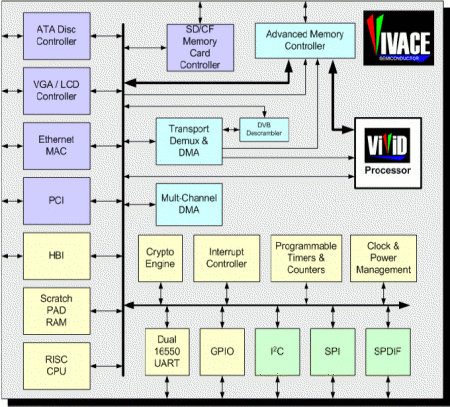Chip startup adopts Linux, open cores for PMPs, DTV
Mar 1, 2006 — by LinuxDevices Staff — from the LinuxDevices Archive — viewsA fabless semiconductor startup focused on “multi-function video processing chips” has adopted Linux and an open-source RISC core. Vivace Semiconductor's roadmap, unveiled at a venture capital event today in San Francisco, includes a VSP200 chip targeting portable video players, and a VSP300 chip targeting high-definition integrated digital TVs (DTVs).
Both of Vivace's chips will run Linux 2.6 on a “Vivid Media” processor that integrates an OpenRISC 1200 core with a collection of engines said to compress, decompress, and decrypt in parallel, allowing multiple media functions to be executed on a single silicon block rather than on different co-processors.

The VSP200 architecture diagram
(Click to enlarge)
VSP200
Vivace claims that its chip for portable media players will deliver 30fps at 720p resolutions, with its Vivid Media core clocked at only 80MHz. The VSP200 integrates extensive power management hardware supporting active, sleep, and power-down modes, Vivace says, and will be positioned as a “low-cost” silicon option. It will delivered with a customizable Linux “host OS environment,” including an on-screen display, according to Vivace.
VSP300
Vivace's chip for non-battery-powered devices features its Vivid Media engine running at 200MHz. This allows it to support NTSC-like (30fps) framerates at full 1080p high-definition resolutions, the company says. The chip was also designed to support wireless access to high-definition video streams.
The VSP300 will be available with a variety of “software modules,” including:
- Multi-channel media framework
- MPEG4 ASP/AVC video
- Windows Media 9/10 video
- JPEG digital still image camera
- Secure encryption support
- Host processor layer
Features common to both chips
Other touted features, for both chips, include:
- Hardware video post-processing for scaling, rotation, etc.
- Integrated LCD controller with up to 32-bit precision, or 64-bit precision for the VSP300
- Numerous on-chip peripheral interfaces:
- DMA
- ATA/CE-ATA
- Integrated memory access package for multiple bitstream sources
- USB 2.0 Slave, I2C, SPI, UART
- AC97, I2S, PCM audio
- GPIO
- JTAG Debug and Emulation
- SD/CF Memory Card Controller
Why Linux?
Vivace says it chose Linux because of its “native support for real-time functionality, multi-processing and multi-threaded execution, [and] extensive bundled software components, including rich networking and graphics.”
Other Linux advantages touted by Vivace include:
- User-selectable modes for real-time execution
- Thread prioritization
- Support for high-resolution POSIX timers
- Linux Security Module said to offer “a lightweight, general-purpose framework for access control” such as DRM (digital rights management)
- Full-strength general-purpose cryptography library
- Supports key networking technologies
- Variety of useful embedded filesystems, such as the MontaVista-contributed PRAMFS
- Rich support for graphics (X Window System)
Interestingly, with the exception of “security applications” possibly related to DRM, Vivace says it expects to provide “all media components” for its chips as open source software, suggesting it may be aiming at “sandbox-sensitive” intellectual property such as proprietary codecs in hardware. Support is planned for Windows Media 9, AVC L3 baseline profile, MPEG-4 advanced simple profile (including DivX), MPEG2 [email protected], MP3, AC3, Dolby Digital and Pro Logic, and JPEG.
CEO Cary Ussery stated, “We have developed a platform that can support a complete range of integrated functionality. Our approach enables maximum flexibility to adapt to changes in standards and market requirements.”
Paul O'Donovan, principal research analyst at Gartner, stated, “The future proliferation of video content available from a wide variety of sources in numerous formats and supported by a multitude of standards requires a flexible and feature-rich silicon platform now. Product developers in these very dynamic markets must be able to incorporate new features and functionality, at competitive price points, so the more programmable and the more integrated a chip solution, the better.”
Availability
Vivace plans to fab both chips using 0.13-micron process technology. Both are expected to sample this summer. Both will be provided with reference designs, boards, and a toolsuite that can be used to develop software for all on-board processors, the company says.
Vivace promises to reveal additional details at the Spring Processor Forum this May, in San Jose.
This article was originally published on LinuxDevices.com and has been donated to the open source community by QuinStreet Inc. Please visit LinuxToday.com for up-to-date news and articles about Linux and open source.